
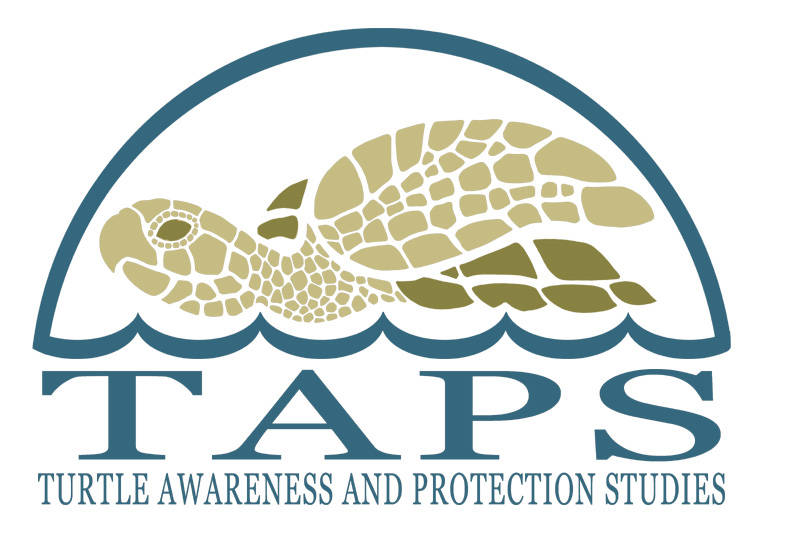
Turtle Awareness and Protection Studies (TAPS)
2007 Research Update
March
We returned to Roatan during March and launched a pilot study to attach radio transmitters to two juvenile turtles and begin tracking them in the south coast area of the island. Our permit finally came thr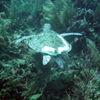 ough and we were able to flipper tag and release all the turtles that were being held in the protective pool at our Conservation Partner, the Reef House Resort.
ough and we were able to flipper tag and release all the turtles that were being held in the protective pool at our Conservation Partner, the Reef House Resort.
On release, each turtle was followed and observed for as long as possible. While some remained in the immediate area for up to 45 minutes, others swam beyond our view within 5-10 minutes. We collected data on their movements, inter-surface and surface times and what they sampled for food.
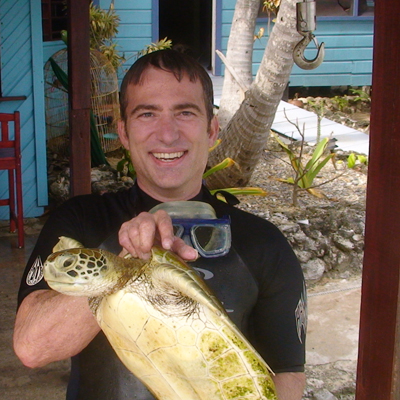 Our newest team member, Dr. Doug Stilson, joined the expedition to film the research and turtles, both above and below the water. We returned from this expedition with hours of excellent, HD video and many photos. We are already planning for the return to Roatan in June, when we will launch the full radio tracking project.
Our newest team member, Dr. Doug Stilson, joined the expedition to film the research and turtles, both above and below the water. We returned from this expedition with hours of excellent, HD video and many photos. We are already planning for the return to Roatan in June, when we will launch the full radio tracking project.
June - August
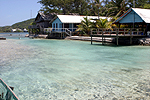 On June 17, Steve returned to Roatan to prepare the groundwork for new MS student, Melissa Berube to arrive later in the month. Shortly after arriving, Steve went to work re-measuring and re-weighing turtles that had previously been measured and released back into the wild in March. Of tho
On June 17, Steve returned to Roatan to prepare the groundwork for new MS student, Melissa Berube to arrive later in the month. Shortly after arriving, Steve went to work re-measuring and re-weighing turtles that had previously been measured and released back into the wild in March. Of tho![]() se that had been released, we received four turtles back that had, once again, been captured by local fishermen in the Port Royal area. The recaptures provided important information on how far these juvenile hawksbills had traveled over the past three months and also how much they had grown (although measurements over a full year and more are needed for more accurate determinations). During this time, we also received in several new juveniles that were likewise measured and photographed. In addition to the usual data collected, during this season we also began to take skin samples for genetic analyses. In the future, these samples will help us understand who is related to whom in this population and who may be from other populations in the region.
se that had been released, we received four turtles back that had, once again, been captured by local fishermen in the Port Royal area. The recaptures provided important information on how far these juvenile hawksbills had traveled over the past three months and also how much they had grown (although measurements over a full year and more are needed for more accurate determinations). During this time, we also received in several new juveniles that were likewise measured and photographed. In addition to the usual data collected, during this season we also began to take skin samples for genetic analyses. In the future, these samples will help us understand who is related to whom in this population and who may be from other populations in the region.
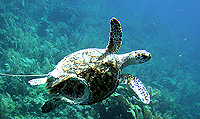 When Melissa arrived at the end of June, we worked quickly to develop and outline her project scope, goals and methods. Within a short time, we were fixing radio transmitters to juvenile hawksbills. After a few days of careful observations, we began releasing the telemetered turtles back into the wild and started an intensive schedule of tracking them each day to collect spatial data on each individual. The goal of this work is to be able to draw a picture of home range areas these young turtles are using, then look at the habitat features that support these turtles and the population, as a whole.
When Melissa arrived at the end of June, we worked quickly to develop and outline her project scope, goals and methods. Within a short time, we were fixing radio transmitters to juvenile hawksbills. After a few days of careful observations, we began releasing the telemetered turtles back into the wild and started an intensive schedule of tracking them each day to collect spatial data on each individual. The goal of this work is to be able to draw a picture of home range areas these young turtles are using, then look at the habitat features that support these turtles and the population, as a whole.
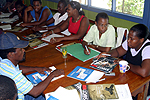 With funding support from SWOT (State of the World’s Sea Turtles), we held a Fishermen’s Turtle Conservation Workshop from July 10 – 12. Local fishers and their families from three communities, as well as representatives from the Bay Islands Natural Resources Integrated Management team and the Roatan Marine Park were in attendance. The workshop was further sponsored by
With funding support from SWOT (State of the World’s Sea Turtles), we held a Fishermen’s Turtle Conservation Workshop from July 10 – 12. Local fishers and their families from three communities, as well as representatives from the Bay Islands Natural Resources Integrated Management team and the Roatan Marine Park were in attendance. The workshop was further sponsored by  Larry and Carol Stevenson of the Reef House Resort (Conservation Partner with ProTECTOR in the TAPS program). Through small group activities and intensive discussion, participants of the workshop successfully linked the islands main sources of income (tourism) with the island’s main resource (the marine
Larry and Carol Stevenson of the Reef House Resort (Conservation Partner with ProTECTOR in the TAPS program). Through small group activities and intensive discussion, participants of the workshop successfully linked the islands main sources of income (tourism) with the island’s main resource (the marine 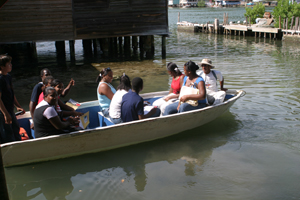 environment). Furthermore, we saw that sea turtles are a well recognized representative of that resource and that if local communities became engaged in marine and sea turtle conservation efforts, they stood to benefit socially, environmentally and financially from their involvement. Together, we developed a concrete plan that includes local community capacity-building, tourism and
environment). Furthermore, we saw that sea turtles are a well recognized representative of that resource and that if local communities became engaged in marine and sea turtle conservation efforts, they stood to benefit socially, environmentally and financially from their involvement. Together, we developed a concrete plan that includes local community capacity-building, tourism and 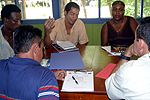 sea turtle conservation into a means by which local communities can provide needed income and be a part of the global sea turtle conservation network. It was a highly successful workshop and we will be moving forward with a proposal for funding throughout the remainder of this year.
sea turtle conservation into a means by which local communities can provide needed income and be a part of the global sea turtle conservation network. It was a highly successful workshop and we will be moving forward with a proposal for funding throughout the remainder of this year.
"Outlook Expeditions" Volunteer Groups
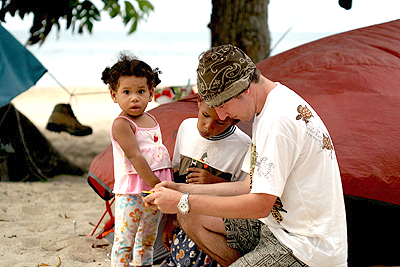
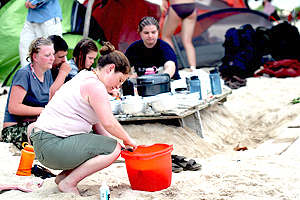 In July we had two volunteer groups from "Outlook Expeditions" in the UK. These groups were organized by Mr. Edwar Stones from the company head office in Scotland. The first group of 12 participants was under the direction of Ms. Cara Allison. They monitored Camp Bay Beach from July 17-21 and Paya Bay Beach East on July 18 and 20.
In July we had two volunteer groups from "Outlook Expeditions" in the UK. These groups were organized by Mr. Edwar Stones from the company head office in Scotland. The first group of 12 participants was under the direction of Ms. Cara Allison. They monitored Camp Bay Beach from July 17-21 and Paya Bay Beach East on July 18 and 20. 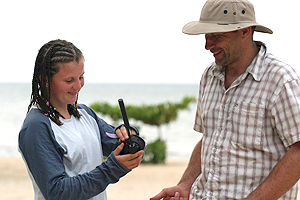
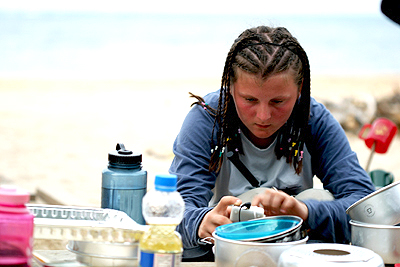 The second group of 11 participants was under the direction of Mr. Tom Allen. They monitored Camp Bay Beach from August 14-17 and Paya Bay Beach East on August 15.
The second group of 11 participants was under the direction of Mr. Tom Allen. They monitored Camp Bay Beach from August 14-17 and Paya Bay Beach East on August 15.
Participants patrolled the beaches throughout the night with two teams of two people. Teams stayed in contact with each other and the base camp by two-way radios, and were provided a cell phone to contact 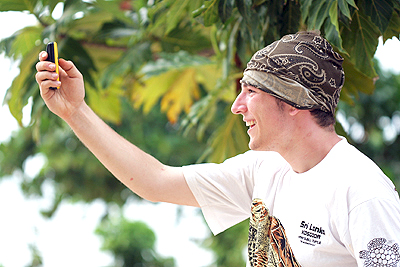 Steve Dunbar in case a turtle was sighted. The beach monitoring protocol included a data collection sheet for both nesting females and hatchlings, as well as a laminated sheet providing distinguishing features of species likely to be ecountered on Roatan for identification.
Steve Dunbar in case a turtle was sighted. The beach monitoring protocol included a data collection sheet for both nesting females and hatchlings, as well as a laminated sheet providing distinguishing features of species likely to be ecountered on Roatan for identification.
Punta Raton
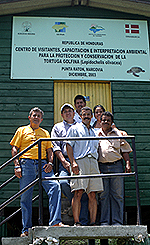 Another exciting development came with the help of future ProTECTOR Honduras Country Director, Lidia Salinas. Lidia has been an integral part of developing plans for ProTECTOR to establish an office in Honduras. On July 24-26, Lidia and Steve met with Ministry of Environment (SERNA) and Department of Biodiversity (DiBio) officials to discuss the potential for ProTECTOR to take the role of the main sea turtle research and c
Another exciting development came with the help of future ProTECTOR Honduras Country Director, Lidia Salinas. Lidia has been an integral part of developing plans for ProTECTOR to establish an office in Honduras. On July 24-26, Lidia and Steve met with Ministry of Environment (SERNA) and Department of Biodiversity (DiBio) officials to discuss the potential for ProTECTOR to take the role of the main sea turtle research and c onservation center for the country of Honduras. Officials were very receptive to the idea and we are currently in the agreement-writing phase of the process. Lidia and Steve also had the chance to visit the local community conservation effort for Olive Ridley (Lepidochelys olivacea) on the Pacific coast of Honduras along the Gulf of Fonseca. We are excited to be involved with this important nesting conservation program and lend technical oversight to the project along with all the community members invested in the successful nesting of these turtles each year.
onservation center for the country of Honduras. Officials were very receptive to the idea and we are currently in the agreement-writing phase of the process. Lidia and Steve also had the chance to visit the local community conservation effort for Olive Ridley (Lepidochelys olivacea) on the Pacific coast of Honduras along the Gulf of Fonseca. We are excited to be involved with this important nesting conservation program and lend technical oversight to the project along with all the community members invested in the successful nesting of these turtles each year.
We look forward to our future work in the region. We anticipate many good tings to come as we work closely with all the individuals and groups interested in understanding and conserving the sea turtles of Honduras.
September
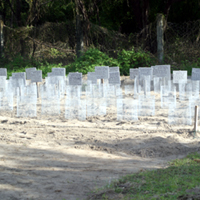 In the second week of September, we had the opportunity to work with the Ministry of Environments (SERNA) and the Municipality of Marcovia along the Gulf of Fonseca on the Pacific coast of Honduras during the nesting season for Olive Ridleys (Lepidochelys olivacea). Local community members assist SERNA in collecting the eggs and placing them in a protected hatchery. This takes place for one month out of the three months of egg-laying. Counts are
In the second week of September, we had the opportunity to work with the Ministry of Environments (SERNA) and the Municipality of Marcovia along the Gulf of Fonseca on the Pacific coast of Honduras during the nesting season for Olive Ridleys (Lepidochelys olivacea). Local community members assist SERNA in collecting the eggs and placing them in a protected hatchery. This takes place for one month out of the three months of egg-laying. Counts are 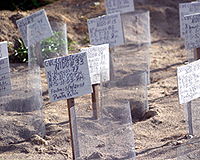 made of the number of nests laid, eggs collected, and successful hatchings, but no data is collected on the females, the number of unsuccessful turtle hatchings, deaths or non-viable eggs. We are beginning a new program of tagging nesting females and collecting important information on the numbers of turtles nesting each year, as well as the number of eggs collected over the entire season and the number of hatchlings returned to the sea. Understanding these dynamics is of key importance for sustaining the population.
made of the number of nests laid, eggs collected, and successful hatchings, but no data is collected on the females, the number of unsuccessful turtle hatchings, deaths or non-viable eggs. We are beginning a new program of tagging nesting females and collecting important information on the numbers of turtles nesting each year, as well as the number of eggs collected over the entire season and the number of hatchlings returned to the sea. Understanding these dynamics is of key importance for sustaining the population.
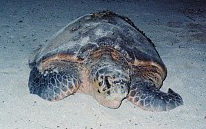 One of our most exciting events in September was the confirmation of a nesting hawksbill on the south coast of Roatan. We confirmed that a single female emerged from the water three times over a period of three weeks and laid two clutches of eggs.
One of our most exciting events in September was the confirmation of a nesting hawksbill on the south coast of Roatan. We confirmed that a single female emerged from the water three times over a period of three weeks and laid two clutches of eggs.  With assistance from local property caretakers, we were able to protect the nests from animals and await the results of the hatchings. We plan to continue to monitor for nesting turtles around Roatan and map these nesting beaches with each confirmation.
With assistance from local property caretakers, we were able to protect the nests from animals and await the results of the hatchings. We plan to continue to monitor for nesting turtles around Roatan and map these nesting beaches with each confirmation.
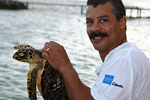
| Data Collectors |
| Bottles 2 Buildings |
| ResearchGate |
| ProTECTOR Inc. Youtube |
| Interns and Volunteers |
| ProTECTOR Store |